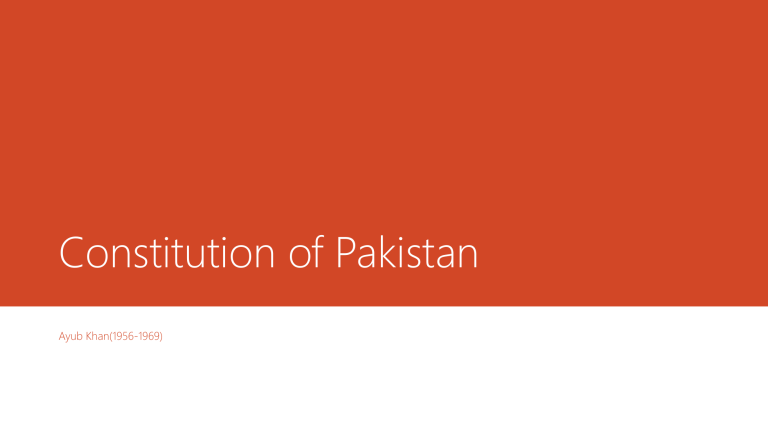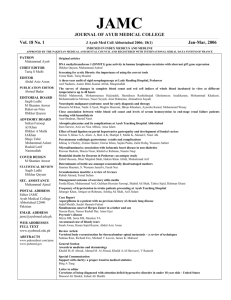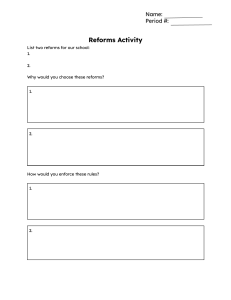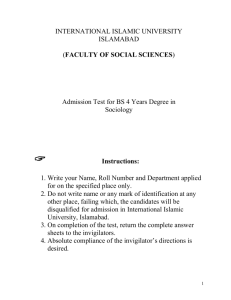
Constitution of Pakistan Ayub Khan(1956-1969) Introduction • The Constitution of Pakistan in 1956 was the fundamental law of Pakistan from March 1956 until the 1958 Pakistani coup d’état. It was the first constitution adopted by independent Pakistan, containing 234 articles divided into thirteen sections and six schedule • In 1958, President Sikandar Mirza declared martial law in Pakistan. • He dissolved the central and provincial assemblies and abolished the 1956 Constitution • General Muhammad Ayub Khan became the Chief Martial Law Administrator. • Ayub Khan eventually removed Mirza from office on October 27, 1958. (1907-1974) Prompt action taken by Ayub Khan • He targeted politicians and political organizations, banning all illegal activities. • The account of various political parties were frozen, and their offices sealed • Several chief leaders were arrested . The EBDO act prevented many political leaders from participating in future • elections. • After assuming power ,the leader took swift action against black marketing, bribery and corruption. • Ayub Khan believed that the political leaders were responsible for Pakistan’s problems and resolved to address them freely Basic Democracy system The basic democracy was introduced by Ayub khan in 1959 • Concept: Ayub khan the president of Pakistan, initiated the concept of basic democracy under the basic democracies order 1959 • Structure: The system consisted of four-tired local government system Union council: The lowest level responsible for local governance within a union. Tehsil council: The next level up, overseeing the affairs at the tehsil(subdestrict )level. District council: Responsible for district level governance. Divisional council: The heighest tier dealing with the matters at divisional level. • Elections: member of these council were directly elected by the people. Constituencies typically consisted of 800-1000 adults. • Link to government: The primary purpose was to create the link between the government and the citizens allowing for more affective administration Presidential refrundum In I 960. Ayub Khan held a referendum to get himself selected as the president of Pakistan. All the members of basic democracies were asked to give their opinion. so he was supponed as the president of Pakistan. Constitution of Pakistan 1962: Background: The 1956 Constitution of Pakistan served as the fundamental law of the country from March 1956 until the 1958 Pakistani coup d'état. It was Pakistan's first constitution after gaining independence. Comprising 234 articles, thirteen parts, and six schedules, this constitution established a parliamentary system with a unicameral legislature called the National Assembly. Notably, it recognized the concept of One Unit, dividing seats equally between East Pakistan and West Pakistan . The Constitution also declared Pakistan as the Islamic Republic, stipulating that only a Muslim could hold the office of President. While it drew inspiration from the Government of India Act 1935 and the 1st Interim Constitution of 1947, it introduced significant modifications, reflecting the nation's unique context and aspirations. Despite these changes, some continuity remained between the 1956 Constitution and its predecessors. Constitution of Pakistan salient features Following are the salient features of constitution of Pakistan Written constitution Fadrel system of government Presidential System National language Rigid constitution Capital of country Veto powers of the president Independent Judiciary Fundamental rights Unicameral legislature Provincial autonomy Indirect Electorate The National Assembly Single citizenship constitutions of 1962 Islamic Provisions: Sovereignty Name of the country President to be a Muslim Islamic law Safety of Islamic institute Islamic research institution Relation with the Muslim countries Elimination of Riba Religious and cultural freedom of minorities Islamic way of life Implementation of Islamic principles Protection of Islamic traditions An Islamic advisory council Ayub Khan’s Reforms Agricultural and land reforms Industrial reforms Labour Reforms Educational reforms Health reforms Family laws ordinance Law of inheritance Ayub Khan’s Reforms Agricultural And Land Reforms After taking over the charge of the country Ayub Khan setup commission for land reforms. Mr. Akbar Hussain was the head of this commission. The commission presented the first agricultural reforms report in 1959. The details of agricultural reforms are as follows. The limit for the possession of the agricultural land and unirrigated land: • • An irrigated land cannot be less than 12.5 acres and cannot be more than 500 acres for an individual man not more than 1000 acres for unirrigated Steps for the promotion of agriculture: Govt. took the steps for the promotion of agriculture. The details are as follows • Agricultural development corporation • Fertilizer factories • Agricultural Bank • Agricultural universities • Solved the cannal water dispute Ayub Khan’s Reforms Industrial Reforms During Ayub Khan's Era During the tenure of General Muhammad Ayub Khan as President of Pakistan, several significant industrial reforms were implemented. Here are the key points: -Privatization and Liberalization: Ayub Khan privatized state-owned industries and liberalized the economy. These measures attracted large inflows of foreign aid and investment, leading to the fastest-growing economy in South Asia. • Oil Refinery: In 1962, Ayub Khan established Pakistan's first oil refinery in Karachi, which played a crucial role in promoting industrialization and meeting energy demands. • Mineral Development Corporation: Ayub Khan set up the Mineral Development Corporation to explore mineral reserves, further supporting industrial growth. • Infrastructure Development: His tenure was marked by the completion of hydroelectric stations, dams, and reservoirs, which contributed to the country's overall economic progress. • Mega Projects: Ayub Khan initiated mega projects such as the construction of the Mangla Dam, the Karachi Steel Mills, and oil refineries. Ayub Khan’s Reforms: Labour Reforms: During Ayub Khan's EraAyub Khan's tenure as President of Pakistan witnessed several important labor reforms. Here are the key points: • Recognition of Unions: Ayub Khan emphasized the importance of labor unions. Factory owners were mandated to recognize elected union councils and consider their opinions in all matters. • Worker Rights: The reforms aimed to protect workers' rights, ensuring fair wages, safe working conditions, and the right to organize and bargain collectively. • Social Security: Ayub Khan introduced social security measures, including provident funds and employee welfare programs, to improve the well-being of workers. • Labor Courts: Specialized labor courts were established to address disputes between employers and employees, ensuring timely resolution and justice. • Minimum Wage: The government set minimum wage standards to prevent exploitation and ensure a decent livelihood for workers. These labor reforms aimed to create a more equitable and just environment for Pakistan's workforce, recognizing their vital role in the nation's development. Ayub Khan’s Reforms Educational Reforms: • According to the recommendation of commission new curricula was compiled and books of new course were written according to the revised curricula. • Primary education would be free and compulsory up to 8th class. • It was recommended that intermediate class be included in secondary education. • The duration of university degree programs was extended from two to three years, allowing for more comprehensive learning and specialization. But the student’s community was strongly against the three years degree program. • English as the medium of instruction will replace gradually with Urdu • A number of politechnical institutes were opened in country. Ayub Khan’s reforms Health reforms: • Ayub Khan made technical education mandatory. This move was intended to address the growing need for skilled professionals in various sectors, including healthcare. • The two-year degree program was extended to three years. This extension allowed for a more comprehensive and in-depth study of medical subjects. • By increasing the duration of medical education, students had more time to acquire knowledge and practical experience, better preparing them for their future roles as healthcare professionals. • As part of the reforms, civil defense training was made mandatory in schools and colleges, including those offering medical education. • In the medical field, this translated to the expansion of medical colleges and the improvement of existing facilities Ayub khan’s reforms Family Law Ordinance (1961): In 1961, during the presidency of Ayub Khan, the Muslim Family Laws Ordinance was introduced in Pakistan. This ordinance aimed to address various aspects of family law and bring about significant changes: The ordinance abolished unmitigated polygamy. Now, a man could not marry more than one wife without the consent of his current wife. • The consent of the existing wife became mandatory for a man to enter into a second marriage • The practice of instant divorce, where a man could pronounce “talaq” thrice in one go, was curtailed. • The ordinance emphasized that Muslim marriages should be registered in accordance with its provisions, overriding any conflicting laws, customs, or usages. • The ordinance established Arbitration Councils to address family matters. These councils consisted of representatives from both parties involved in a dispute. • Ayub Khan’s Reforms Law of inheritance: • Throught the law of inheritance by Ayub Khan the grand children were made eligible to inherit their grand father’s property even if their father had died in the life time of their father.




